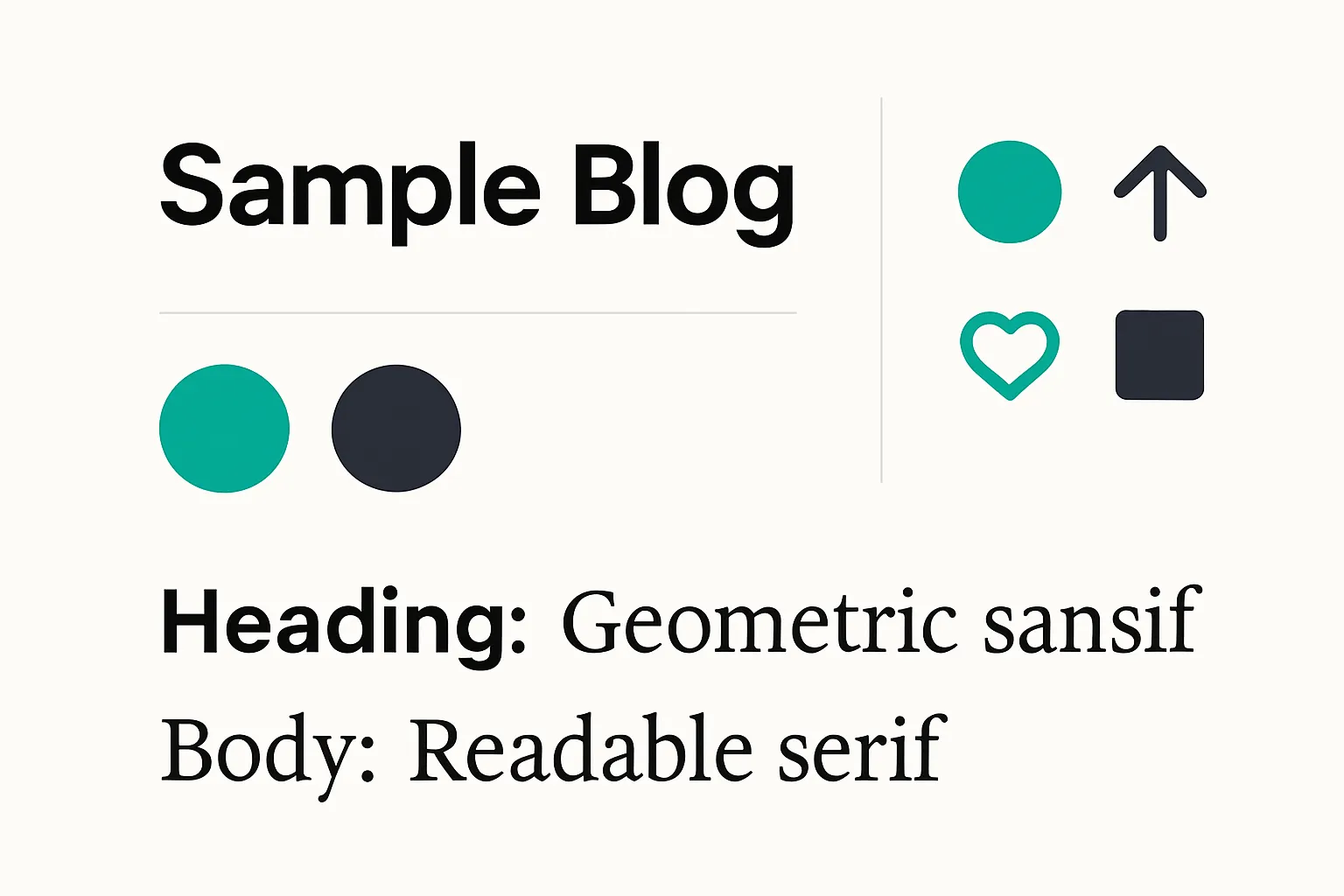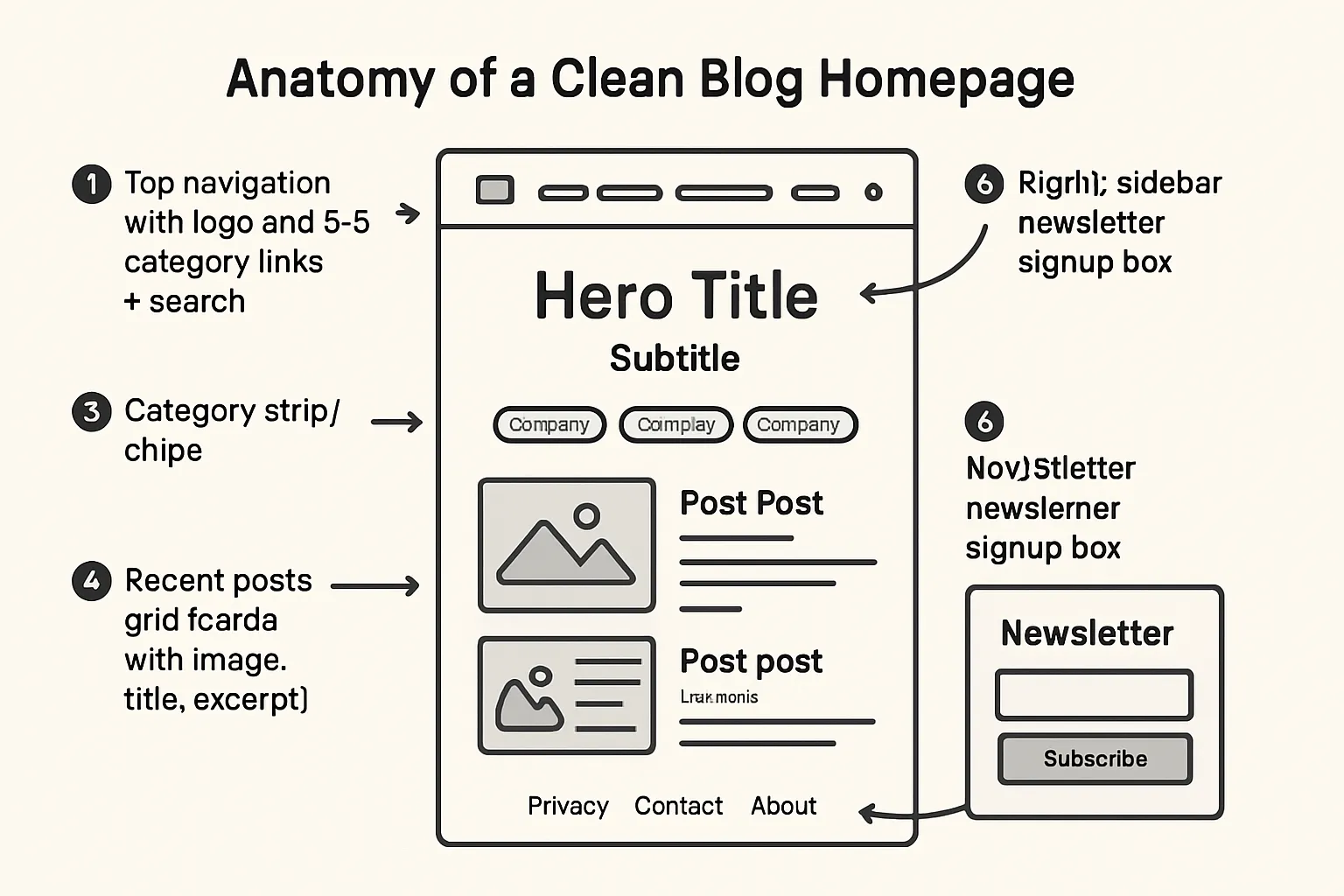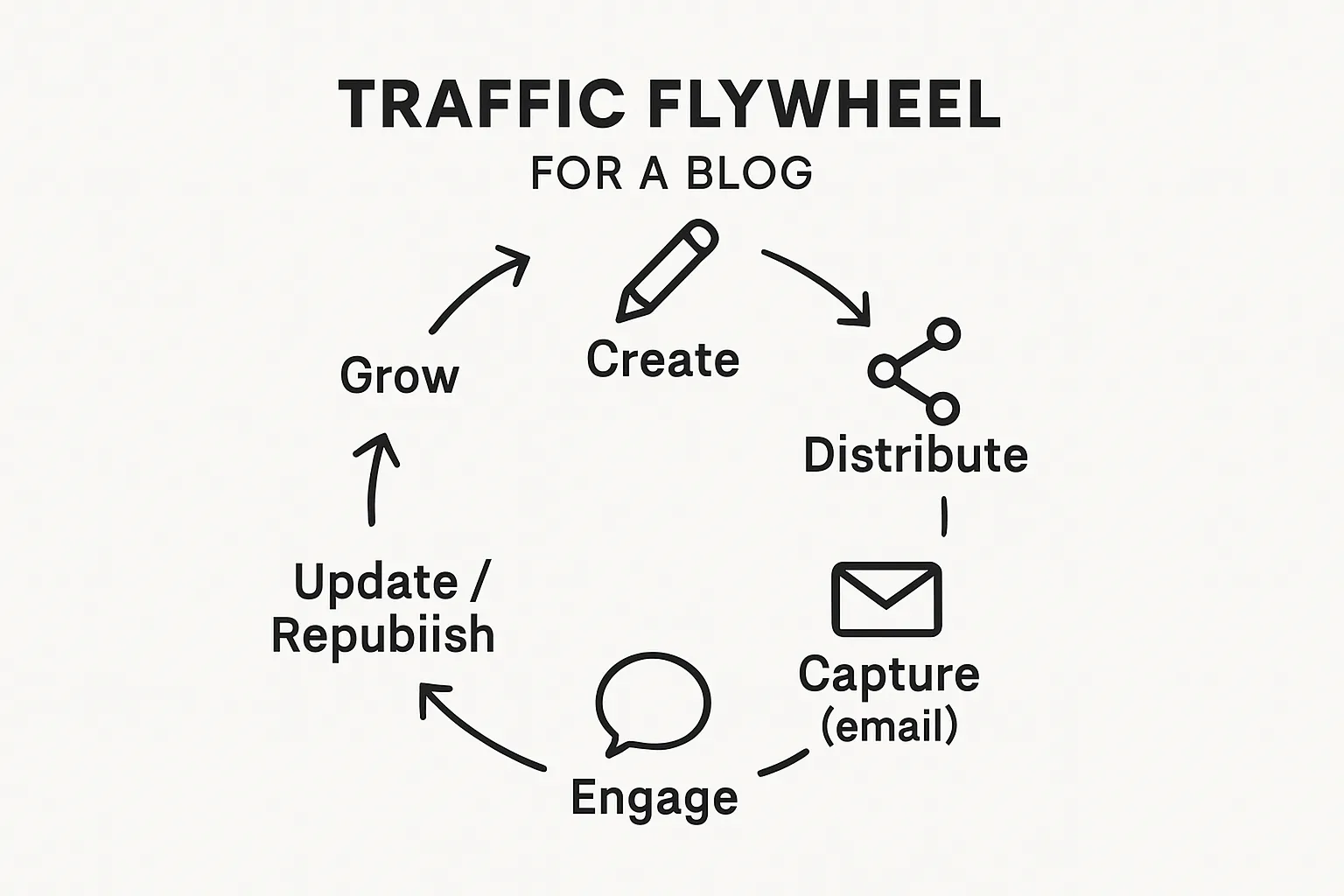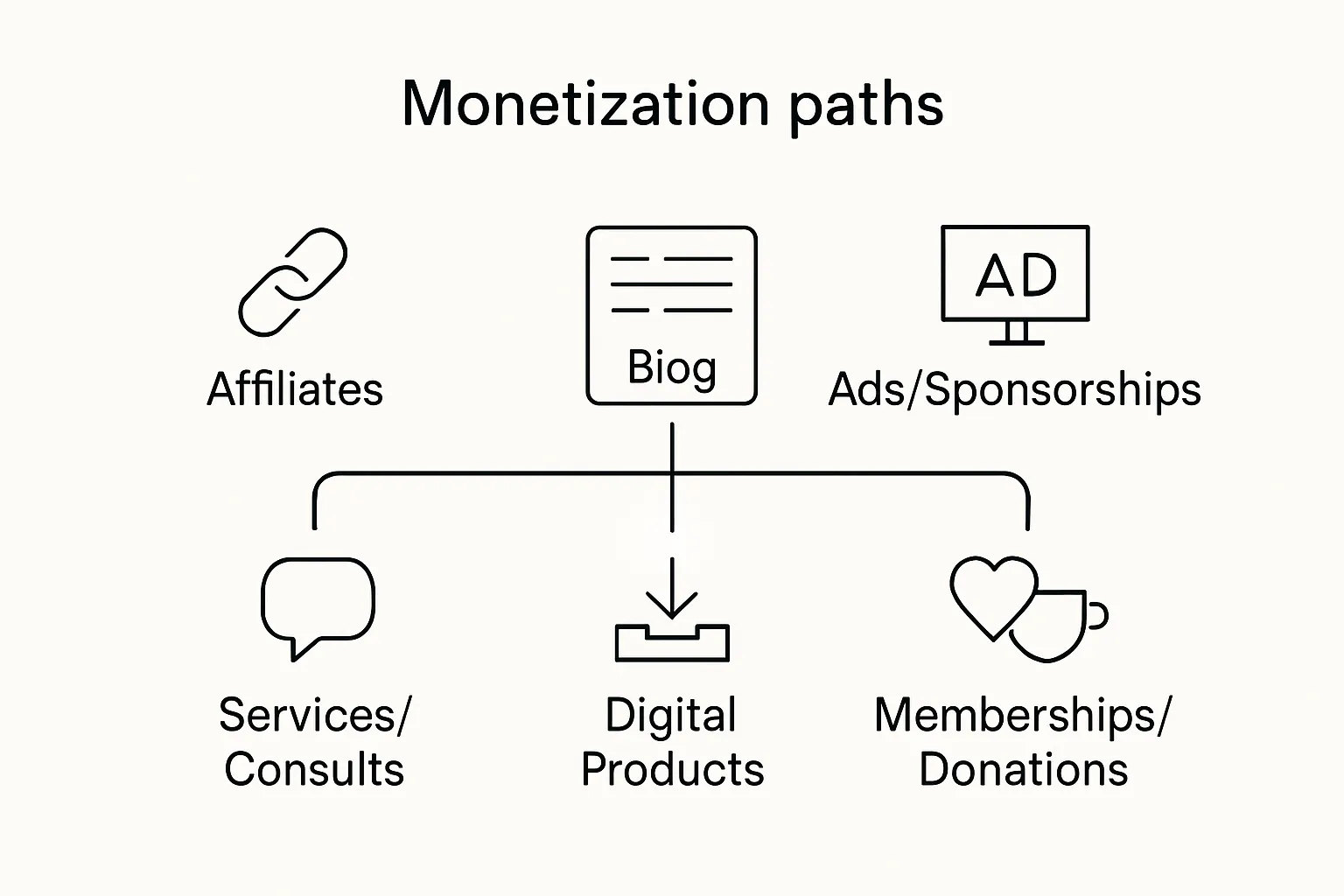Start a Free Blog in 2025: What You’ll Achieve in 20 Minutes
Launch a polished, search‑ready blog without spending a cent. In the next 20 minutes, you’ll:
Choose a niche and name that can rank and be remembered
Spin up a free blog (on a subdomain) with an SEO‑optimized template
Publish your first post (with images and internal links)
Turn on basic analytics and an email signup
Learn exactly when to stay free - and when to upgrade for growth
With BlogBowl, you can create free blog projects fast - then scale with AI‑assisted content, internal linking, and built‑in newsletter tools when you’re ready.
Why “create free blog” still works in 2025
"Businesses that blog get 55% more website visitors than those that don’t." - Source
Search is still the lowest‑cost channel for compounding traffic. A free blog lets you validate your niche, audience, and content style before you invest. When you’re ready, platforms like BlogBowl help you keep that momentum - migrating seamlessly to custom domains, faster templates, and automated SEO.
What you’ll need (and what you won’t)
No code, no budget, just a device and an internet connection
A niche idea and a working title (you can change the name later)
1–2 seed topics for your first post
Optional: a logo or brand color (helpful, not required)
What you won’t need today:
No paid domain (start on a free subdomain)
No premium theme or plugins
No complex setup or hosting contracts
What this guide covers (10-step roadmap and free tools)
From picking a niche to your first 100 readers
Validate with quick keyword checks and competitor scans
Draft, format, and publish your first post with free editors
Turn on a free email list and basic analytics
Promote smartly on one or two channels that match your niche
When to stay free vs. when to upgrade
Stay free while validating topics, tone, and traction
Upgrade when you hit clear signals: consistent traffic, newsletter growth, or monetization goals (custom domain, faster themes, advanced SEO, AI automations with BlogBowl)
Who this is for
Beginners launching their first site
Side‑projects testing demand before investing
SaaS/startups validating ideas and capturing early SEO
Creators building authority, email lists, and income streams
Ready to start a free blog and publish in minutes? This guide shows the exact steps - plus when to flip the switch to pro features so your growth never stalls.
Quick-Start: Build a Free Blog in 15 Minutes
Prefer to watch? Here’s a complete 15‑minute walkthrough of creating a free blog - from signup to publishing your first post.
"Blogs that prioritize educational content receive 52% more organic traffic than those centered on company news." - Backlinko
The 5-minute decisions
Pick a niche and working title (keep it descriptive)
Examples: “Vegan Weeknight Meals,” “Indie SaaS Growth Notes,” “Learn Python for Analysts.” Descriptive titles improve clarity and searchability - perfect for a fast, free launch.
The 10-minute setup
Choose a free platform (WordPress.com, Blogger, Medium, Substack)
Tip:WordPress.com/Blogger: most flexible for themes and pages
Medium/Substack: fastest to publish and built-in audiences/newsletters
Claim your free subdomain (yourname.wordpress.com etc.)
Keep it short, memorable, and aligned with your niche. You can map a custom domain later without losing content.Select a clean, mobile-first theme
Choose a simple, fast template with good typography and clear headings. Most readers land on mobile - prioritize readability and speed.
Publish your Hello World post
Write a quick intro: who you are, who this blog helps, what to expect next.
Add 1–2 helpful internal sections (e.g., your first mini guide or resource list).
Add a simple About blurb and contact method
Add an “About” page (2–3 sentences is fine for now)
Include a contact form or email (e.g., via your platform’s built-in pages)
Turn on basic stats/analytics if available
Optional: launch faster with automation
When a business needs pro features, spin up on BlogBowl in under 60 seconds (import later if starting free elsewhere).
You’ll get SEO‑optimized templates, built‑in newsletter, privacy‑friendly analytics, and AI‑powered content automation to scale beyond your free starter.
Pick Your Free Platform (and When to Upgrade)
Best free options to create a free blog
WordPress.com, Blogger, Medium, Substack, Wix (free), Tumblr, GitHub Pages
Free Blogging Platforms Comparison
Platform | Custom Domain on Free Plan | SEO Control | Ads Allowed | Monetization Options | Export/Portability | Ideal For |
|---|---|---|---|---|---|---|
WordPress.com | No (subdomain only) | Limited (basic SEO; no plugins) | WordPress may show ads; own ad networks require upgrade | Affiliate links (with restrictions), WordAds on paid plans | Yes (WXR/XML) | Beginners who want an easy CMS and a clear path to upgrade |
Blogger | Yes (you can map a custom domain) | Basic controls; editable templates | Yes (AdSense supported) | AdSense, affiliate links, sponsorships | Yes (XML export) | Hobbyists who want free hosting with simple monetization |
Medium | No (custom domain typically paid for publications) | Limited (Medium controls most SEO) | No third‑party display ads | Medium Partner Program, paid memberships | Yes (ZIP export) | Writers who want built‑in distribution and a clean editor |
Substack | No (custom domain requires paid) | Limited (basic post metadata) | No display ads | Free/paid email subscriptions, tips | Yes (posts + subscribers export) | Newsletter‑first creators who want fast setup |
Wix (free) | No (wixsite.com subdomain) | Good basic SEO tools (no custom domain) | Wix branding/ads shown; own ad networks require upgrade | Limited (ecommerce/ads require paid) | Limited (migration can be manual) | Visual site builders prototyping quickly |
Tumblr | Yes (custom domain mapping) | Limited (theme/meta; minimal structured SEO) | Limited (theme-based ad code/affiliate links) | Affiliate links, tips, possible theme ad code | Yes (export tool) | Microblogging, fandoms, visuals, short‑form posts |
GitHub Pages | Yes (CNAME mapping) | High (full control via static site generators) | Allowed via custom code (self‑managed) | Affiliates, sponsorships, manual ad embeds | Complete (it’s just files/Git) | Developers comfortable with Git and static sites |
BlogBowl (Upgrade Path) | Yes | Advanced, automated SEO | Yes | Ads, affiliates, memberships/newsletter, products | One‑click export/import | Businesses needing automation, analytics, and SEO at scale |
What to prioritize on a free plan
SEO control: Ability to set titles, meta descriptions, headings, slugs, and canonicals.
Portability/export: Clean exports (XML/Markdown) to avoid lock‑in when you migrate.
Monetization rules: Know what’s allowed (ads, affiliates, subscriptions) before you start.
Customizations: Mobile‑first theme, fast performance, and basic styling flexibility.
Support/community: Active docs, forums, and templates to solve issues quickly.
When to switch (or start) with a growth platform
If you want automated SEO, scheduling, analytics, newsletter + custom domain: use BlogBowl.
BlogBowl adds AI‑assisted content, automatic internal linking, keyword research, embedded media, built‑in newsletter, custom domains, privacy‑friendly analytics, and pro‑grade SEO templates - so you can grow faster without extra tools.
Migration note
Export from your free platform (e.g., WordPress WXR, Medium/Substack ZIP, Blogger XML).
Clean up slugs, titles, and categories in a spreadsheet to preserve URL structure.
Import into your new platform (BlogBowl supports guided import), then set 301 redirects from old URLs to new ones.
Rebuild internal links and resubmit sitemaps to Search Console to retain rankings.
Name, Domain, and Brand Basics (Still Free)
How to name your blog (fast framework)
Descriptive + memorable + short (use words your audience searches)
Use plain-language keywords your readers already type (e.g., “vegan lunches,” “no‑code analytics,” “remote dev tips”).
Add a twist for memorability: “Vegan Lunch Lab,” “No‑Code Analyzer,” “Remote Dev Notes.”
Check availability: search engines, trademarks, and your social handles.
Keep it free (for now)
Use a platform subdomain (e.g., yourname.wordpress.com, yourtopic.substack.com) while you validate your niche and voice.
Reserve matching social handles on the channels you’ll use - even if you don’t post yet. Consistency helps future branding.
Plan for a custom domain later
Why it matters: boosts trust, improves click‑through rates, and signals permanence to readers and partners.
SEO note: mapping a custom domain consolidates authority under one clean URL.
How to map it when ready:
Buy a domain from a registrar, 2) connect it in your platform (DNS A/CNAME), 3) enable SSL, 4) set canonical to the custom domain, 5) test redirects (www ↔ root), 6) resubmit sitemaps.
Simple brand kit in 10 minutes
2 colors: one brand color (primary), one neutral (text/background)
2 typefaces: a strong sans‑serif for headings, a readable serif or humanist sans for body
Logo mark (optional): simple shape or initials you can reuse as a favicon and social avatar

Set Up and Design: Fast, Clean, Mobile-First
Pick a minimal theme (avoid carousel overload)
Choose a lightweight, mobile‑first template with:
Clear typography (16–18px body, 28–36px H2s)
Single hero title (no auto‑playing carousels)
Simple grid for recent posts
Built‑in dark text on light background for readability
Essential pages (keep it simple)
About: who you help and what readers will get
Contact: a form or email link, plus your preferred response time
Privacy Policy (basic): even on free plans, add a simple policy for analytics/newsletter tools
Start Here: a short primer with links to your best 3–5 posts
Navigation that guides readers
3–5 top categories only; visible search in the header
Avoid mega menus; use short, scannable labels (e.g., Guides, Reviews, Tutorials, News, Resources)
Link Start Here and About in the header or footer for easy discovery
SEO-friendly settings (on free plans)
Permalink best practices: use short, keyword‑rich slugs (e.g., /vegan-lunch-ideas)
Titles/meta: write benefit‑driven titles; add concise meta descriptions where the platform allows
Image alt text: describe the image and include a keyword naturally (don’t stuff)
Accessibility and performance basics
Contrast: meet WCAG AA (≥ 4.5:1 for body text)
Font size/line‑height: 16–18px body, 1.5–1.7 line height, 45–90 character measure
Image compression: export at ~70–80% quality; use responsive sizes; lazy‑load if available
Motion sensitivity: avoid auto‑playing sliders and parallax effects

Your First 6 Posts: Templates That Rank (and Help)
Mix of evergreen + timely content
3 evergreen guides, 2 list posts, 1 opinion/interview
Aim for search-friendly topics around “start a free blog” and “create free blog,” plus one timely perspective to earn shares
Simple post templates
How‑to: Problem → Steps → Checklist → FAQs → CTA
Listicle: Hook → Criteria → Items → Next steps
Review: Who it’s for → Pros/Cons → Alternatives → Verdict
6‑Post Launch Plan
Post Type | Working Title | Target Keyword | Search Intent | CTA |
|---|---|---|---|---|
How‑to (Evergreen) | How to Start a Free Blog in 15 Minutes (No Code, No Budget) | start a free blog | Informational/Transactional | Get the free checklist + publish your first post today |
Guide (Evergreen) | Create a Free Blog: 10‑Step Starter Checklist for 2025 | create free blog | Informational | Download the 10‑step checklist + subscribe for weekly tips |
List Post (Commercial) | 7 Best Free Blogging Platforms Compared (Pros/Cons) | best free blogging platforms | Commercial Investigation | See our platform comparison + plan your migration path |
List Post (Evergreen) | 25 First‑Post Ideas for New Free Blogs (With Titles) | blog post ideas for beginners | Informational | Copy the ideas + grab our title formulas PDF |
Review/Comparison | WordPress.com vs Blogger vs Substack (Free Plan Showdown) | wordpress.com vs blogger | Commercial Investigation | Read the verdict + get our clean migration guide |
Opinion/Interview (Timely) | Is Blogging Still Worth It in 2025? Marketer Q&A + Real Results | is blogging still worth it 2025 | Informational | Join the newsletter + get case-study updates |
On‑page SEO in 5 minutes per post
Primary keyword in H1, first 100 words, 1–2 H2s, and naturally in alt text
Short, readable slug (e.g., /start-free-blog-15-minutes)
Internal links: point to your comparison, checklist, and related posts (2–4 links)
External link: cite one credible source
Schema basics: use Article/BlogPosting (headline, description, author, date, image)
Meta description: 150–160 characters with a clear benefit and keyword
Image hygiene: compressed, descriptive filenames (e.g., free-blog-setup-hero.jpg), alt text that describes the image
Final pass: skim for scannability (short paragraphs, bullets, subheads), add a clear CTA at the end of the article
Get Your First 100 Readers for Free
"Email marketing delivers an average ROI of $36–$50 for every $1 spent, with retail/ecommerce averaging ~45:1." - Litmus

SEO fundamentals that compound
Keyword targeting: map 1–2 primary queries per post (e.g., “start a free blog,” “create free blog 2025”).
Internal linking: every new post links to 2–3 older posts and one “Start Here” hub.
Smart interlink hub: create a “Start Here” page that links to your 3–5 cornerstone posts; link back to it from those posts.
Social without burnout
Pick 1–2 channels that already fit your niche (e.g., Reddit + LinkedIn, or Instagram + Threads).
Native snippets + link: post a quote, insight, or mini‑tutorial natively; add your blog link in comments or bio.
Repost cadence: reshare top snippets weekly for 4–6 weeks; rotate visuals and hooks.
Communities that actually welcome links
Niche forums and subreddits: look for weekly “Share” or “Feedback” threads; offer value first (summarize key tips before linking).
Relevant FB/Slack groups: answer questions with concise, actionable advice; link only when it truly helps.
Track acceptance: note which communities welcome your posts - double down on the 2–3 that consistently engage.
Start an email list on a free tier
One lead magnet: “Free Blog Launch Checklist (10 Steps)” as a simple PDF/Google Doc.
One 3‑email welcome series:
Your story + quick wins,
Best 3 resources (internal links),
Small ask (reply with niche/topic, or share your post).
Weekly roundup: a short summary with 1 key insight and 2 relevant links.
Repurpose one post into 5 assets
Thread: 6–8 bullet insights on LinkedIn/X.
Short video: 30–60s explainer for Reels/Shorts/TikTok.
Carousel: 5–7 slides covering steps or mistakes.
Newsletter section: condense into a “Tip of the Week.”
PDF checklist: turn the core steps into a downloadable lead magnet.
Follow this flywheel - Create → Distribute → Capture → Engage → Update → Grow - and your first 100 readers will compound into your first 1,000.
Monetize a Free Blog (Ethically, and Early)
"Disclose any material connection clearly and conspicuously when endorsing products - financial ties, free products, or other relationships must be obvious to consumers." - FTC Endorsement Guides

Low‑lift options on free plans
Affiliate links (with disclosure): link to products you genuinely recommend; add a clear note at the top (e.g., “This post contains affiliate links - at no cost to you, we may earn a commission”).
Services/consults: add a “Work With Me” page; offer audits, 1:1 consults, or done‑for‑you packages.
Simple digital downloads: checklists, templates, or short guides delivered via cloud links or email signups.
Ads and sponsorships
When ad networks make sense: consider them once you have consistent traffic; test placements to protect UX.
Brand‑safe placements: keep ads below the fold or between sections; avoid intrusive interstitials and auto‑play.
Reader revenue without friction
Tip jars and donations: Buy Me a Coffee, Ko‑fi, or PayPal.me links on your About and footer.
Substack memberships or paid posts: offer bonus posts/Q&As; keep your free cadence alive.
Early supporters: grant perks like templates, office hours, or discounts on future products.
Compliance essentials in plain English
FTC disclosures: use unambiguous labels (#ad, “sponsored,” “affiliate link”). Place disclosures where they’re hard to miss (above the fold; near the endorsement).
Privacy policy: state what data you collect (analytics, email), why, and how to opt out.
Cookie notices: where required, inform users about cookies/trackers and provide choices.
Email compliance: confirm consent (double opt‑in if possible); include an unsubscribe link in every message.
Monetize early - but keep trust first. Clear disclosures, relevant offers, and brand‑safe UX make revenue and readership grow together.
Maintain, Measure, and Improve (60‑Minute Weekly Routine)
The weekly checklist
Block one hour, same time each week:
Publish or update 1 post (15 min): tighten intro, add 1 new section, refresh outdated stats, add a “Last updated” note.
Add 2 internal links (10 min): from the new/updated post to 2 relevant posts - and add 2 links back into it from older posts.
Compress images (5 min): rename with descriptive filenames, add alt text, and re‑export at ~70–80% quality.
Reply to comments (10 min): answer questions, thank readers, and turn common questions into a short FAQ section.
Fix small snags (10 min): check for broken links, fix typos, ensure headings (H2/H3) are scannable, and re‑submit the updated URL in Search Console.
Log wins and to‑dos (10 min): jot down what moved, what to test next, and the top content ideas you discovered.
Track what matters (all free)
Use a simple spreadsheet and update weekly:
Search Console (Performance):
Queries: rising impressions with low CTR (add title/meta tweaks).
Top pages: note average position and CTR; flag those hovering at positions 5–12 for optimization.
Countries/devices: ensure mobile is healthy; confirm you’re getting impressions where your audience is.
Search Console (Pages/Indexing):
Coverage: fix “Crawled – currently not indexed” and other warnings.
Sitemaps: confirm the latest sitemap was fetched.
Basic analytics (Plausible/GA/your platform):
Top landing pages and traffic sources.
Email signups (or other CTAs) per page.
Average time on page and exit rate for your top 10 posts.
Refresh to win
Small, consistent improvements compound:
Update stats and sources: replace old figures; link to credible references; show “Updated on” date.
Expand sections: add 1–2 paragraphs, a mini checklist, or a quick case example.
Add FAQ schema: answer 2–3 common questions at the end; mark up as FAQ where your platform allows.
Improve headings: make H2s benefit‑driven; add clarifying H3s for scannability.
Visual hygiene: compress/resize images; add a simple diagram where helpful.
Trust signals: author byline, brief bio, and contact link; cite sources; add a clear CTA at the end.
Common pitfalls to avoid
Thin content: 200–300 word posts that can’t rank or help - expand or consolidate.
Stock‑photo overload: irrelevant or repetitive images - use purposeful visuals and diagrams instead.
Ignored comments: unanswered questions hurt trust - reply weekly and learn from them.
No CTA: every post should clearly invite the next step (subscribe, download, read next, contact).
Broken links & redirected slugs: don’t change URLs casually; if you must, set 301 redirects.
Keyword stuffing: write naturally; optimize titles, one H2, and the intro - then focus on value.
Ready to Scale? Start Free, Then Grow on BlogBowl
Why businesses outgrow free plans
Free plans are perfect for validating an idea - but they eventually slow growth:
Limits on SEO: restricted meta control, no schema automation, weak internal linking, and fewer opportunities to target long‑tail queries.
Domains and trust: you’re stuck on a subdomain, which reduces click‑throughs and brand credibility.
Speed and UX: shared, slower infrastructure and heavy themes hurt Core Web Vitals.
Analytics: sampled or shallow data, no holistic funnel view.
Team workflow: single‑author publishing, no approvals, no roles, and limited media management.
How BlogBowl accelerates growth (and saves time)
Launch a professional, search‑ready blog in under 60 seconds - and scale without extra tools:
Launch in <60 seconds; fast SEO templates; integrated newsletter; privacy‑friendly analytics; custom domains
AI automations: daily SEO posts, internal linking, keyword research, embedded media, unique images
Manage multiple blogs, authors, and changelogs/help docs in one place
What this means in practice:
Publish more with less effort: AI drafts, edits, and enriches posts with images and video embeds.
Rank faster: SEO‑optimized templates, automatic internal linking, and topic clustering out of the box.
Own your audience: built‑in newsletter and list growth tools - no Zapier maze required.
Clear visibility: privacy‑friendly analytics tied to content performance, not just pageviews.
Operate like a team: roles, approvals, scheduled posts, and a central media library.
Move when it’s right for you
You can start free on any platform and migrate when ready - BlogBowl supports clean imports:
Import content, map your domain, keep your audience
Preserve links and set 301 redirects to protect rankings
Maintain your RSS and newsletter continuity
Keep your brand look with flexible themes and style controls
Call to action
Create your free blog today. When you’re ready to grow traffic on autopilot, spin it up on BlogBowl: https://www.blogbowl.io


